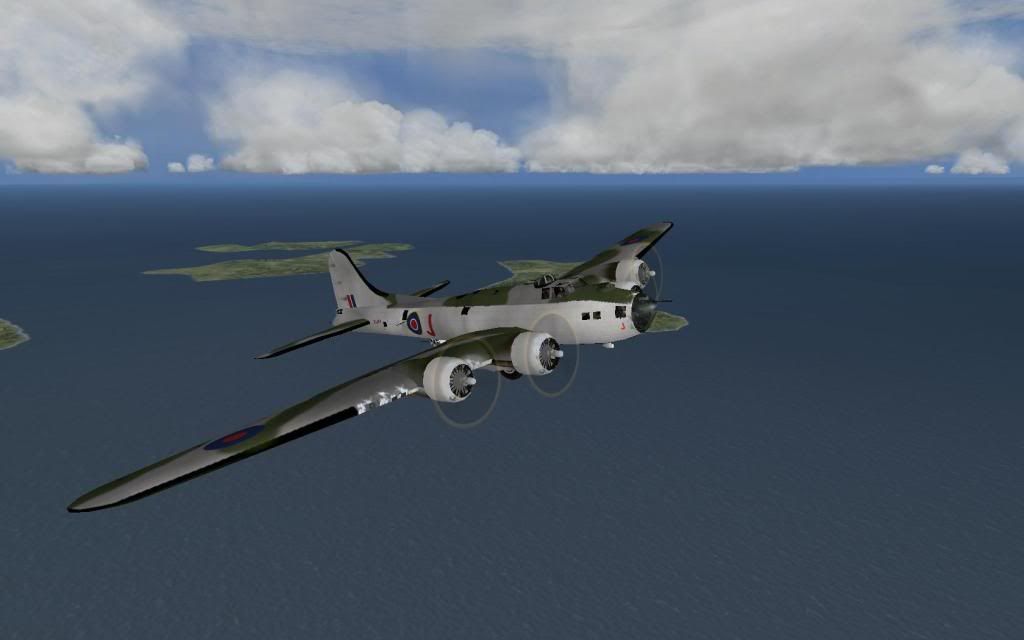46 B-17Es were supplied to the RAF, which designated them the "Fortress IIA". The Fortress II, confusingly, was the designation given to the later B-17F in RAF service. The RAF had originally been promised 300 of the better B-17Fs, but USAAF requirements had forced a change in plans, and so a smaller batch of B-17Es were provided instead, resulting in the switched designations.
The RAF hadn't forgotten their bad experience with the Fortress I and had mixed feelings about the new Fortresses as well. The RAF judged the B-17E's tail and belly turrets to be ineffectual; that was possibly unfair, since for most of the war the defensive armament of RAF bombers consisted of 7.7 millimeter (0.303 caliber) machine guns that lacked hitting power, and RAF bombers generally lacked belly armament, making them painfully vulnerable to attacks from the bottom. However, the RAF also didn't much care for the B-17's unarguably small bombload. The British were no longer focusing on high-altitude daylight strategic bombing at the time in any case, and so the Fortress IIA was pressed into service with the RAF Coastal Command for ocean patrol, where its long range was a clear asset. It was designated "Fortress GR.II" in this role
19 B-17Fs were supplied to the RAF Coastal Command, which designated them "Fortress IIs", as mentioned earlier. They were used with their Fortress IIA (B-17E) predecessors for antisubmarine patrol, with the designation of "Fortress GR.IIA" in this role. They were armed with depth charges, and many were later fitted with longwave "Mark III ASV (Anti-Surface Vessel)" radar, with "stickleback" aerials along the fuselage spine and Yagi antennas underneath the wings. The Fortress Mark II/IIAs proved capable at their role and were credited with sinking 13 U-boats. They were eventually replaced in this role by Liberators and Sunderlands, and were then put into service for weather reconnaissance, where their high-altitude capabilities were a definite asset.
A number of B-17E & Fs which were switched to the 8th USAAF from an RAF order had already been camoflaged in RAF colours as shown here:
http://www.markstyling.com/1ad_b17s1.htm and picture below.
On 17 August 1942, 18 B-17Es of the 97th, including
Yankee Doodle, flown by Major Paul Tibbets and Brigadier General Ira Eaker, were escorted by RAF Spitfires on the first USAAF raid over Europe, against railroad marshalling yards at Rouen-Sotteville in France.
In early 1944, 14 B-17Fs were transferred to the RAF from the USAAF 8th Air Force to be converted into electronic warfare platforms of various types. They were designated "Fortress II(SD)", where "SD" stood for "Special Duty", and used as flight trainers for electronic warfare variants of the later B-17G, or "Fortress III" as it was called in RAF hands.
Eighty-five USAAF B-17Gs were transferred to the Royal Air Force as the Fortress III. The first 30 of these planes were built by Boeing, and the remainder were built by Lockheed-Vega. RAF serials were HB 761/790 for the Boeing-built models and HB791/793, 795, 796, 799/803, 805, 815/820, KH998, KH999, and KJ100/127, KL830/837 for the Vega-built models. However, HB794,797,798,804, 806/814 were diverted to the USAAF before they could be delivered to the RAF.
Three of these Fortress IIIs (HB786, HB791, and HB792) were operated by RAF Coastal Command. They all served with 220 Squadron in the Azores and were subsequently allocated to two met squadrons (HB786 to 521 Sqdn and HB791 and HB792 to 251 Sqdn). They usually carried twelve 400-pound S.C.I. bombs or sixteen 250-pound depth charges. They had the cheek-mounted machine guns removed, and radar was fitted in place of the ball turret.
In February 1944, the first Fortress IIIs were assigned to No. 214 Squadron of Bomber Command based at Sculthorpe before moving to Oulton as Sculthorpe was closed for conversion to 'very heavy bomber configuration'. These operated with No. 100 group on special electronics countermeasures missions to confuse and jam enemy radar. With No. 223 Squadron, the first Fortress III unit of Bomber Command, they took part in clandestine operations until the unit was disbanded in July of 1945. Fortress IIIs also took part in mass night attacks, being employed as decoys to confuse enemy night fighters and to drop "window".






